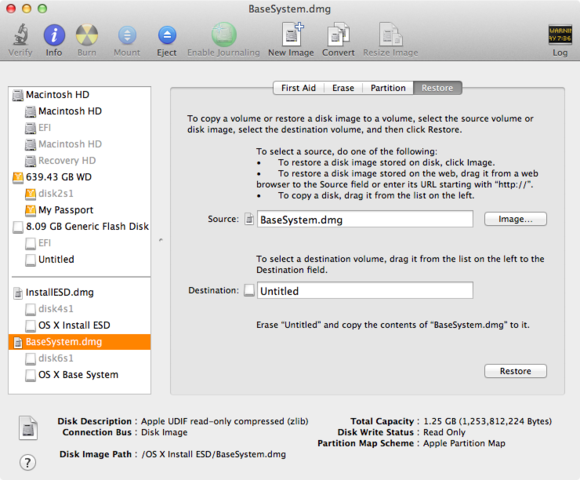Crear Usb Booteable Mavericks Dmg
Posted By admin On 30.11.20Aug 17, 2016 ★ GRABAR ISO o DMG en USB con EL CAPITAN. Crear un USB booteable con OS para MAC desde WINDOWS 2020 Win32 Disk Imager. Instalar OS X Mavericks desde un pendrive USB. TransMac - Make DMG File Bootable USB on Windows. This is a fairly robust application for creating bootable USB on Windows from a DMG file. However, there's a preparatory step to be executed before you can create the bootable USB drive. Apple has created a support page that explains, in large, how to create a bootable USB drive with the OS X 10.9 Mavericks setup file on board. It is not very detailed (which is where the following. Though you can install Mavericks (OS X 10.9) directly from your Mac's hard drive, a bootable installer drive can be more convenient for installing the OS onto multiple Macs. And if your Mac is. Dec 21, 2017 How to Make Bootable USB drive with.DMG for Tiger, Leopard, Lion, Mountain Lion, Mavericks OS X - Duration: 7:43. Tech & Design 65,780 views. Using a Mac with at least OS X 10.6.8 installed, access the Mac App Store and download the Mavericks (10.9) app installer. Insert the USB drive into the Mac and launch Disk Utility. Click on the USB drive from the left-hand menu and select the Partition tab. Click the drop-down menu, selecting 1 partition.
Jesus Vigo goes over the steps to create a bootable USB to install OS X 10.9 (aka Mavericks). Shared Support and double-click the InstallESD.dmg file mount OS X Install ESD on the desktop.
On Monday Apple finally unveiled to the world the next iteration of OS X, Mavericks. A developer preview of the new operating system is available now as a Mac App Store download for registered developers. Delivering Mavericks via a download is super conveient and easy for everyday users but can be unhelpful in several troubleshooting or advanced OS modification situations. The only way to obtain a bootable OS X Mavericks USB flash drive is to create your own:
Crear Usb Booteable Mavericks Dmg Free

Crear Usb Booteable Mavericks Dmg Windows 10
The Marek Bell blog notes that creating a bootable flash drive of Mavericks is a bit more intricate than Mountain Lion because “it is no longer possible to simply restore the InstallESD.dmg to get a bootable image for USB / Flash drive installation.” But there is a way around this obstacle, which Marek outlines in his thorough walkthrough of creating a bootable OS X Mavericks flash drive. You will need at least a 8GB Flash Drive (USB 3.0 is obviously a better choice).
This game boy is designed to run excellent emulators such as the NES, Atari260, and MAME on Emulation station or Retropie. This will enable you to play all your favorite Gameboy games, on a modern, fast gaming portable console.The kit includes:. You’ll also need a 2500 mAh battery, soldering tools, and Silicone.Second on our list is the Pocket PiGRRL kit. One 1 A USB charger. One PiTFT 2.4″ 320×240 TFT Touchscreen. Gameboy dmg display 3d print.

- You are going to need to see some hidden files for this. So start by opening Terminal.app and pasting in the following (don’t worry, we’ll undo this change when we are done)…
defaults write com.apple.Finder AppleShowAllFiles YESkillall Finder - Download the installer as normal from the app store. (At time of writing this is only possible for those with access to the developer previews).
- After download you will have the ‘Install OS X 10.9′ app in your /Applications folder. Right-click it and select ‘Show Package Contents’.
- Navigate to the Contents/SharedSupport. There you will see the InstallESD.dmg file. Unfortunately, you can’t just grab it and restore it. Instead double-click it to mount it.
- You should now see the normally hidden BaseSystem.dmg file in the mounted volume.
- Open Disk Utility and restore the source BaseSystem.dmg to the destination of your USB drive.
- Now open up the restored USB volume (default name is OS X Base System) and navigate to System/Installation. In there you will see an alias for Packages. Delete this alias.
- Copy the full Packages folder from the root of the mounted InstallESD volume (the same place you got the BaseSystem.dmg file) to the USB volumes System/Installation folder. Basically, replace the Packages alias you just deleted with the real Packages folder from the original InstallESD volume.
- The USB drive should now be bootable. So simply restart, hold down the Option key (Alt) when booting with the USB drive in your machine, and you should get the option to boot from the USB drive.
- Remember, to rehide the normall hidden files just repeat step 1 but change YES to NO.
FTC: We use income earning auto affiliate links.More.